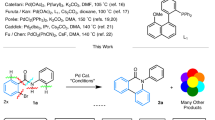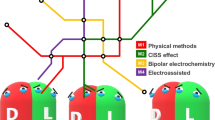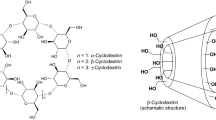Summary
TFA-amino acid esters and TFA-dipeptide esters have been employed as optically active stationary phases for the resolution of amino acid enantiomers by gas chromatography. Structural consideration of the hydrogen bonded diastereoisomeric association complex formed during the separation of amino acid enantiomers led to the synthesis of an N-acyl-amino acid n-alkyl amide (N-caproyl-L-valine n-hexyl amide). This amino acid derivative fulfills the general requirements for the reversible association between the enantiomers and the asymmetric solvent molecules. The results obtained show that the amide portion, when in competition with the ester portion of a dipeptide phase, is involved in formation of the diastereoisometric association complex between the enantiomeric solutes and the chiral solvent by hydrogen bonds.
Zusammenfassung
TFA-Aminosäure-Ester und TFA-Dipeptid-Ester sind als optisch aktive stationäre Phasen für die Trennung von Aminosäure-Enantiomeren mit Hilfe der Gas-Chromatographie verwendet worden. Strukturelle Betrachtungen des durch Wasserstoffbrücken gebildeten diastereomeren Anlagerungskomplexes für die Trennung von Aminosäure-Enantiomeren haben zur Synthese eines N-Alkyl-Aminosäure-n-Alkyl-Amids (N-Caproyl-L-Valin n-Hexylamid) geführt. Dieses Aminosäurederivat erfüllt die allgemeinen Bedingungen für eine reversible Assoziation zwischen den Enantiommeren und der assymetrischen Trennflüssigkeit. Die erhaltenen Resultate zeigen, daß der Amid-Anteil, wenn auch immer in Konkurrenz mit dem Ester-Anteil einer Dipeptid-Phase, für die Ausbildung des diastereoisomeren Assoziationskomplexes zwischen dem enantiomeren Stoff und der Trennflüssigkeit gebildet wird, verantwortlich ist.
Résumé
Des esters de trifluoroacétyl-(TFA-)aminoacides et de TFA-dipeptides ont été employés comme phases fixes optiquement actives pour la séparation des énantiomères d'acides aminés par chromatographie en phase gazeuse. Des considérations sur la structure du complexe formé par association de diastéréoisomères par liaisons hydrogène durant la séparation des énantiomères d'acides aminés nous ont conduit à synthétiser un n-alkylamide d'acide aminé N-acylé (N-caproyl-L-valine-n-hexylamide). Ce dérivé d'acide aminé remplit la condition générale requise pour l'association (reversible) entre les énantiomères et la molécule asymétrique de solvant. Les résultats obtenus montrent que le groupe amide, quand il entre en compétition avec le groupe ester de la phase dipeptidique entre en jeu dans la formation du complexe produit par association de diastéréoisomérique entre les solutés enantiomères et le solvant complexant par liaison hydrogène.
Similar content being viewed by others
References
E. Gil-Av, B. Feibush, andR. Charles-Sigler, in “Gas Chromatography, 1966” ed.,A. B. Littlewood, Institute of Petroleum, London, 1967, p. 227.
E. Gil-Av, B. Feibush, andR. Charles-Sigler Tetrahedron Letters (1966) 1009.
B. Feibush andE. Gil-Av, J. Gas Chromatog.5, 257 (1967).
J. A. Corbin, andL. B. Rogers, Anal. Chem.42, 974 (1970).
E. Gil-Av andB. Feibush, Tetrahedron Letters, 3345 (1967).
B. Feibush andE. Gil-Av, Tetrahedron26, 1361 (1970).
S. Nakaparskin, P. Birrell, E. Gil-Av, andJ. Oró, J. Chromatog. Sci.8, 177 (1970).
W. A. König, W. Parr, H. A. Lichtenstein, E. Bayer andJ. Oró, J. Chromatogr. Sci.8, 183 (1970).
W. Parr, J. Pleterski, C. Yang, andE. Bayer, J. Chromatog. Sci.9, 141 (1971).
W. Parr, C. Yang, E. Bayer andE. Gil-Av, J. Chromatog. Sci.8, 591 (1970).
W. Parr, C. Yang, J. Pleterski andE. Bayer, J. Chromatog.50, 510 (1970).
W. Parr andP. Howard, Chromatographia (1971), 162.
J. A. Corbin, J. E. Rhoad andL. B. Rogers, Anal. Chem.,43, 327 (1971).
W. König andR. Geiger, Chem. Ber.103, 788 (1970).
Author information
Authors and Affiliations
Rights and permissions
About this article
Cite this article
Grohmann, K., Parr, W. Investigation of the diastereoisomeric association complex for the separation of amino acid enantiomers on optically active stationary phases. Chromatographia 5, 18–22 (1972). https://doi.org/10.1007/BF02270651
Received:
Accepted:
Issue Date:
DOI: https://doi.org/10.1007/BF02270651




